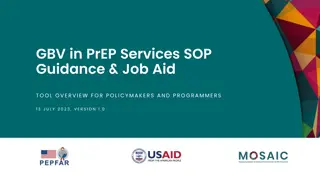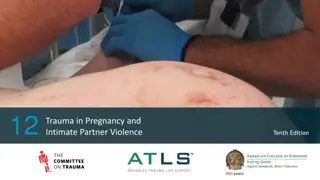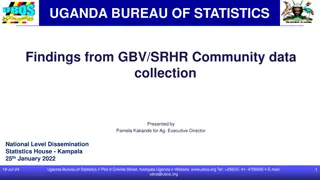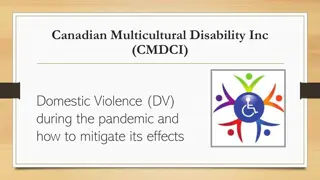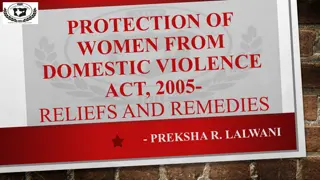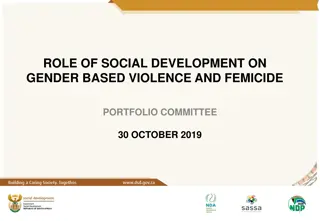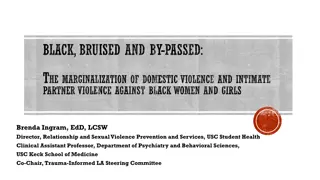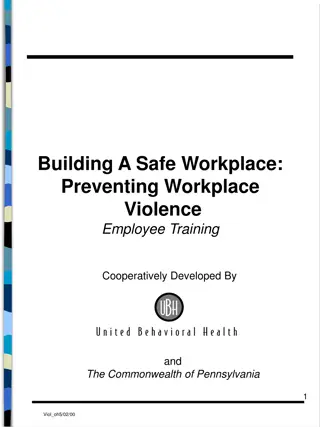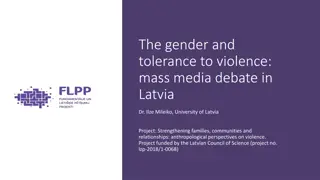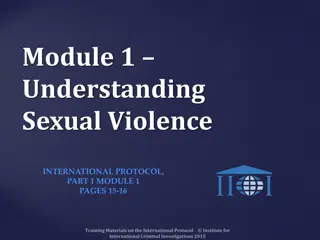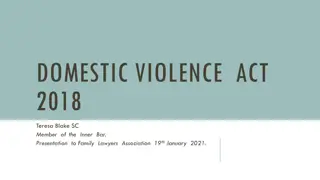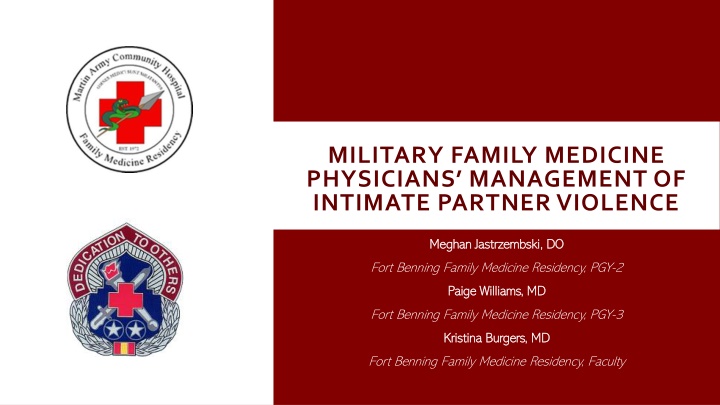
Military Family Medicine Physicians: Intimate Partner Violence Management Insights
Explore the comprehensive insights shared by military family medicine physicians on the management of intimate partner violence, including screening recommendations, current rates, military implications, study population breakdown, and survey design insights.
Download Presentation

Please find below an Image/Link to download the presentation.
The content on the website is provided AS IS for your information and personal use only. It may not be sold, licensed, or shared on other websites without obtaining consent from the author. If you encounter any issues during the download, it is possible that the publisher has removed the file from their server.
You are allowed to download the files provided on this website for personal or commercial use, subject to the condition that they are used lawfully. All files are the property of their respective owners.
The content on the website is provided AS IS for your information and personal use only. It may not be sold, licensed, or shared on other websites without obtaining consent from the author.
E N D
Presentation Transcript
MILITARY FAMILY MEDICINE PHYSICIANS MANAGEMENT OF INTIMATE PARTNER VIOLENCE Meghan Jastrzembski, DO Meghan Jastrzembski, DO Fort Benning Family Medicine Residency, PGY-2 Paige Williams, MD Paige Williams, MD Fort Benning Family Medicine Residency, PGY-3 Kristina Burgers, MD Kristina Burgers, MD Fort Benning Family Medicine Residency, Faculty
DISCLOSURE The views and statements in the presentation are solely from the investigators. They do not represent the opinions or positions of the department of defense or the United States Army. The investigators have no financial disclosures. The investigators have no financial disclosures. The views and statements in the presentation are solely from the investigators. They do not represent the opinions or positions of the department of defense or the United States Army.
BACKGROUND Intimate Partner Violence (IPV) Screening Recommendations AAFP-Grade B USPSTF-Grade B
CURRENT SCREENING RATES 1.5%-12% Civilian Sector
MILITARY IMPLICATIONS 10,000 incidents per year 30 %
MILITARY IMPLICATIONS 15 homicides
OBJECTIVE Recognize Understand Identify
DESIGN 2022 Omnibus Survey n=321 Anonymous data collection Survey Breakdown: Demographic questions 10 survey questions Likert scale Statistical tests How confident are you in addressing the impact of intimate partner violence on other health conditions? a. Not at all confident b. Slightly confident c. Confident d. Very confident How often are your patients screened for intimate partner violence prior to you seeing them? a. Never b. Sometimes c. Usually d. Always
STUDY POPULATION 61% Response Rate
STUDY POPULATION FEMALE 135 (42%) MALE 176(54.8%) GENDER TRANSGENDER, NON-BINARY, OROTHER 2 (0.006%) PREFER NOT TO RESPOND 8 (0.02%)
STUDY POPULATION WHITE 237 (73.8%) BLACKOR AFRICAN AMERICAN 14 (3.1%) NATIVE AMERICAN 4 (1.2%) ASIANOR PACIFIC ISLANDER 46 (14.3%) RACE/ETHNICITY HISPANICOR LATINX 16 (4.9%) MULTI-ETHNICOR OTHER 6 (1.8%) PREFERNOTTOANSWEROR NO RESPONSE 12 (3.7%)
RESULTS-CONFIDENCE How confident are you in addressing the impact of intimate partner violence on health? not/somewhat confident 208 (77.3%) very/extremely confident 61 (22.7%) p=0.436
RESULTS-EXPERIENCE During residency, approximately how many patients did you encounter who were experiencing intimate partner violence? None 104 (44%) One 68 (29%) Multiple 63 (27%) P=0.045
RESULTS-EDUCATION During residency, approximately how many training sessions did you receive about intimate partner violence? None 85 (36%) One 111 (46%) Multiple 43 (18%) (p=0.791)
RESULTS How aware are you about resources for intimate partner violence in your local community? 65%
DISCUSSION Limited statistical significance Respondent diversity
DISCUSSION Barriers to provider intervention Gap in patient care Recommendations vs. current practice Current training and confidence is not consistent with prevelance
NEXT STEPS Future Studies
CONCLUSION Application to military providers Call to action
REFERENCES 1. Policies - Intimate Partner Violence. American Academy of Physicians. https://www.aafp.org/about/policies/all/intimate-partner-violence.html. Published 2019. Accessed January 10, 2021. 2. Intimate Partner Violence: Final Recommendation Statement. US Preventive Services Task Force. https://www.uspreventiveservicestaskforce.org/uspstf/recommendation/intimate- partner-violence-and-abuse-of-elderly-and-vulnerable-adults-screening. Published October 23, 2018. Accessed January 10, 2021. 3. Hamberger LK. Preparing the next generation of physicians: medical school and residency-based intimate partner violence curriculum and evaluation. Trauma Violence Abuse. 2007 Apr;8(2):214-25. doi: 10.1177/1524838007301163. PMID: 17545575. 4. Kalra N, Hooker L, Reisenhofer S, Di Tanna GL, Garc a-Moreno C. Training healthcare providers to respond to intimate partner violence against women. Cochrane Database of Systematic Reviews 2021, Issue 5. Art. No.: CD012423. DOI: 10.1002/14651858.CD012423.pub2. Accessed 08 January 2023. 5. Understanding and addressing violence against women : Intimate partner violence. World Health Organization. https://apps.who.int/iris/handle/10665/77432. Published January 1, 1970. Accessed January 8, 2023. 6. Centers for Disease Control and Prevention. Intimate Partner Violence Surveillance Uniform Definitions and Recommended Data Elements Version 2.0. https://www.cdc.gov/violenceprevention/pdf/ipv/intimatepartnerviolence.pdf. 2023 7. Centers for Disease Control and Prevention. National Intimate Partner and Sexual Violence Survey 2010 Summary Report. https://www.cdc.gov/ViolencePrevention/pdf/NISVS_Report2010-a.pdf. 2023 8. Gierisch JM, Shapiro A, Grant NN, et al. Intimate Partner Violence: Prevalence Among U.S. Military Veterans and Active Duty Servicemembers and a Review of Intervention Approaches. Department of Veterans Affairs (US), Washington (DC); 2013. PMID: 25232637. 9. CFR.org, ed. Demographics of the U.S. Military. https://www.cfr.org/backgrounder/demographics-us-military#chapter-title-0-3. Published July 13, 2020.
REFERENCES 10. Bonomi AE, Anderson ML, Rivara FP, Thompson RS. Health care utilization and costs associated with physical and nonphysical-only intimate partner violence. Health Serv Res. 2009 Jun;44(3):1052-67. doi: 10.1111/j.1475-6773.2009.00955.x. Epub 2009 Mar 17. PMID: 19674432; PMCID: PMC2699921. 11. Campbell JC. Health consequences of intimate partner violence. The Lancet. 2002;359(9314):1331-1336. doi:10.1016/s0140-6736(02)08336-8 12. Intimate partner violence. ACOG. https://www.acog.org/clinical/clinical-guidance/committee-opinion/articles/2012/02/intimate-partner-violence. Published 2022. Accessed January 8, 2023. 13. Jowers K. How bad is DoD s domestic abuse problem? Unclear, thanks to data gaps, auditors say. Military Times. 2021 May 7. Accessed at https://www.militarytimes.com /pay- benefits/2021/05/07/how-bad-is-dods-domestic-abuse-problem-unclear-thanks-to-data-gaps-auditors-say/. 14. Pagels, P., Kindratt, T.B., Reyna, G. et al. Establishing the Need for Family Medicine Training in Intimate Partner Violence Screening. J Community Health 40, 508 514 (2015). https://doi.org/10.1007/s10900-014-9964-1 15. Waalen, Jill, et al. Screening for intimate partner violence by health care providers: barriers and interventions. American journal of preventive medicine 19.4 (2000): 230-237. 16. 6 Centers for Disease Control and Prevention (CDC). (2013). Intimate Partner Violence During Pregnancy: A Guide for Clinicians. 17. Insetta ER, Christmas C. A Novel Intimate Partner Violence Curriculum for Internal Medicine Residents: Development, Implementation, and Evaluation. MedEdPORTAL. 2020 May 27;16:10905. doi: 10.15766/mep_2374-8265.10905. PMID: 32656326; PMCID: PMC7331963.

